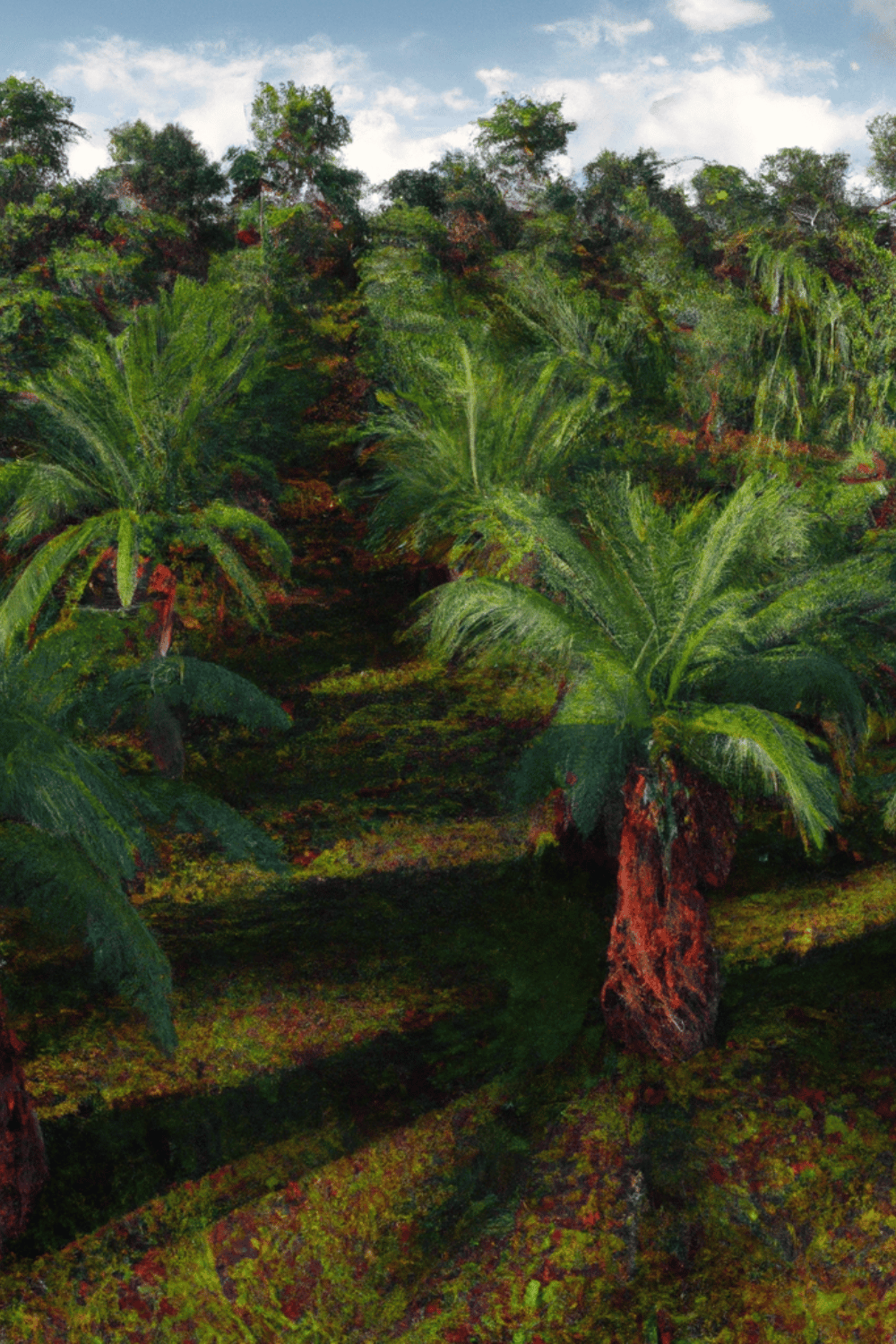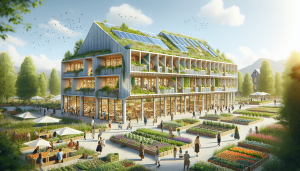The world of palm oil is as slippery as a banana peel on a wet floor. Not merely due to its oiliness but also its complexity. The substance finds its way into a significant chunk of everyday items, from the snack you munch on during movie nights to the detergent that tackles your laundry. But here’s the pickle – it’s also notorious for leaving a giant environmental footprint. Enter our green champion: sustainable palm oil.
The Palm Oil Dilemma
What is Palm Oil?
In a nutshell, palm oil is an edible vegetable derived from oil palm trees’ fruit. It’s a jack of all trades in our daily life, infiltrating everything from lip-smacking chocolates to essential toiletries. Think of it as the chameleon of the consumer world!
Why Palm Oil Poses a Problem
So what’s all the fuss about? Here’s the lowdown. Traditional palm oil production is heavily linked to deforestation, habitat destruction, and climate change. It’s like inviting a bull into a china shop – things are bound to get messy.
Impact on Biodiversity
Regular palm oil production is like playing Jenga with our ecosystem, removing crucial pieces that can cause the whole structure to topple over. This loss of habitat leads to species extinction and significantly impacts biodiversity. It’s like removing the birds from a Hitchcock film – it’s not the same movie without them.
Social and Human Rights Issues
And it’s not just the orangutans and tigers that suffer. The palm oil industry is often under fire for labor abuses, forced labor, and other social issues. It’s like an epic saga with too many villains and not enough heroes.
The Green Alternative: Sustainable Palm Oil
Definition of Sustainable Palm Oil
But don’t lose hope just yet. The dark clouds have a silver lining – sustainable palm oil. This version of palm oil doesn’t come with all the destructive side effects. Instead, it’s produced with an eye for environmental preservation, biodiversity protection, and respect for local communities and workers.
Why Switch to Sustainable Palm Oil?
Switching to sustainable palm oil is like swapping the last season’s fashion for the newest trend – it’s smarter, more ethical, and ultimately a game-changer. Here are the reasons you should consider this switch:
Lowering Carbon Footprint
One of the most impactful reasons to switch to sustainable palm oil is the significant reduction in our carbon footprint it allows. Conventional palm oil production involves deforestation, which releases large amounts of carbon dioxide, a potent greenhouse gas. It’s like lighting a massive, uncontrollable bonfire in Mother Nature’s living room.
On the other hand, sustainable palm oil is like dousing that fire. Production methods that adhere to sustainable practices drastically reduce CO2 emissions by preventing deforestation and peatland drainage. It’s not just about putting out the fire; it’s about not lighting it in the first place.
Moreover, sustainable palm oil plantations can also act as carbon sinks, absorbing CO2 from the atmosphere. It’s like having your own team of forest-based superheroes constantly working to reverse the effects of climate change.
Preserving Biodiversity
Switching to sustainable palm oil plays a vital role in conserving biodiversity. Traditional palm oil production can be likened to a catastrophic movie plot where the villain wreaks havoc on the local ecosystem, pushing exotic species to the brink of extinction.
Sustainable palm oil, however, flips the script. It protects vital habitats and preserves biodiversity by prohibiting land clearing and enforcing strict regulations. Think of it as a wildlife-friendly fairy godmother, ensuring the survival of endangered species and maintaining the delicate balance of our ecosystems.
Supporting Fair Trade and Workers’ Rights
Sustainable palm oil doesn’t just benefit the planet; it also supports the people. Unfortunately, the conventional palm oil industry has a track record tainted with issues such as unfair wages, unsafe working conditions, and child labor. It’s like the dark underbelly of an otherwise glamorous industry.
In contrast, sustainable palm oil supports fair trade and workers’ rights. Companies adhering to sustainable practices commit to providing decent working conditions, fair wages, and respecting workers’ rights. It’s like turning on the lights, pushing away the shadows, and revealing a fair and just work environment.
Higher Yields
Here’s a fun fact: oil palms are the most efficient oil crop in the world. They can produce more oil per acre of land than any other equivalent vegetable oil crop. Therefore, choosing sustainable palm oil isn’t just an ethical decision; it’s also a smart one.
By improving plantation management practices, sustainable palm oil production can yield even more oil on the same amount of land. It’s like upgrading your car to a model that gives you more mileage on the same amount of fuel – a no-brainer!
Demand and Supply Dynamics
Finally, let’s talk economics. The demand for palm oil is high and isn’t likely to drop. If we boycott palm oil altogether, producers might switch to other oil crops, which are less efficient and require more land, causing even more deforestation.
By choosing sustainable palm oil, we’re sending a clear message to producers – we demand palm oil, but it must be produced responsibly. It’s like being a discerning consumer who values the product and the process.
In conclusion, switching to sustainable palm oil is an impactful step towards a more sustainable future. So, the next time you pick up a product from the supermarket shelf, look for that RSPO label. Remember, the power to make a difference is literally in your hands!
Where is Sustainable Palm Oil Harvested?
Palm oil trees thrive in tropical climates, so you’ll find most of them basking in the sun in countries near the Equator. However, not all palm oil is created equal. So, where does sustainable palm oil come from?
A Global Effort
Sustainable palm oil is harvested worldwide, but the primary producers are found in Southeast Asia, particularly Malaysia and Indonesia. It’s kind of like sourcing the finest spices from various corners of the world – each region contributes to the mix.
Countries Leading in Sustainable Palm Oil Production
While Indonesia and Malaysia hold the lead in sustainable palm oil production, other countries are catching up. Latin American countries like Colombia, African nations like Ghana, and even some regions in Papua New Guinea are joining the race toward sustainable palm oil production.
It’s important to remember that sustainable palm oil isn’t just about where it’s grown but how it’s grown. That’s where the Roundtable on Sustainable Palm Oil (RSPO) comes into play, ensuring sustainable practices are upheld regardless of location.
The Processing of Sustainable Palm Oil
Sustainable palm oil production is like creating a fine piece of art. It requires careful planning, detailed knowledge, and a whole lot of respect for nature. Here’s how it’s done:
Plantation Establishment and Management
Firstly, new plantations can’t be established by clearing primary forests or areas with significant concentrations of biodiversity or fragile ecosystems. It’s like choosing the perfect site for a picnic – you wouldn’t pick a spot in the middle of a blooming flower bed.
Existing plantations are managed following best practices. That includes maintaining the health of the palm trees, employing integrated pest management to minimize pesticide use, and practicing responsible waste management. Imagine it as running a top-notch hotel where every detail matters.
Harvesting
The fresh fruit bunches are harvested by hand, using sharp tools to cut off the bunch without harming the tree. It’s like giving the tree a careful trim, not a hasty shave.
Milling and Production
After the harvest, the fruits are transported to mills, where they’re sterilized, threshed (removing the fruit from the bunch), and pressed to extract the oil. The leftover parts aren’t wasted – they’re used to create biomass, which can be turned into renewable energy. It’s like cooking a meal where every bit of the ingredient is utilized – nothing goes to waste.
Certification
Finally, throughout this process, everything is monitored and audited regularly to maintain RSPO certification. It’s the equivalent of passing a rigorous exam with flying colors – and continuing to do so year after year!
In a nutshell, the sustainable palm oil process is a perfect blend of respect for the environment, care for social issues, and attention to economic viability. It’s a gentle dance with Mother Nature, where every step is taken with care.
The Journey to Sustainability: A Roadmap
Our journey to sustainability is a bit like climbing a mountain. It may seem daunting at first, but every step brings us closer to the peak. Here are a few steps we can take on our journey:
Step One: Awareness and Education
First things first, let’s spread the word. The more people know about sustainable palm oil, the more impact we can make. So tell your friends, your family, and even your noisy neighbor. Shout it from the rooftops if you have to!
Step Two: Choose RSPO Certified Products
RSPO stands for Roundtable on Sustainable Palm Oil. They’re the watchdogs for sustainable palm oil, ensuring that it’s produced ethically and sustainably. Next time you’re shopping, check for their label. It’s like choosing a restaurant based on hygiene ratings. It makes a big difference!
Step Three: Encourage Transparency in Supply Chains
Transparency is essential. It’s like going behind the scenes at a magic show. The more we know about what’s going on behind the curtain, the better we can understand (and influence) the overall performance.
The Benefits of Sustainable Palm Oil
Environmental Benefits
Sustainable palm oil can be a superhero for the environment, helping to preserve rainforests, protect endangered species, and combat climate change. If this were a comic book, sustainable palm oil would definitely wear a cape!
Socioeconomic Benefits
On the socioeconomic side, sustainable palm oil can uplift local communities and ensure fair labor practices. It’s like a friendly neighborhood Spider-Man, always looking out for the little guy.
The Role of Governments and Legislation
Of course, it’s not all up to the individual. Governments and legislation have a major part to play too. Like the referees in this sustainability game, they ensure everyone plays by the rules.
Legislation
Introducing legislation that promotes sustainable palm oil production can make a huge difference. It’s like a speed limit sign on a highway, guiding everyone to safer practices.
Incentives for Sustainable Practices
Similarly, providing incentives for sustainable practices can motivate producers to switch to sustainable methods. It’s like offering an extra cookie for cleaning up your room – who could resist?
Common Misconceptions
Many people believe sustainable palm oil is just a myth. But remember: it’s not about eliminating palm oil; it’s about transforming its production. It’s like turning a caterpillar into a butterfly – a beautiful metamorphosis!
Sustainable Palm Oil: A Reality Check
The Role of Big Corporations
Let’s face it; big corporations significantly impact the industry. They have the power to effect change. But remember, as the wise Uncle Ben told Spider-Man, “With great power comes great responsibility.”
The Role of Consumers
We, consumers, are no side characters in this story. We have a critical role to play too. Our choices can make a significant difference. It’s like voting for the environment with every dollar we spend.
Future of Palm Oil: Innovations in Sustainability
The realm is constantly innovating, evolving, and improving. Much like the world of technology, it’s in a state of perpetual forward motion, striving for a more sustainable, equitable, and efficient future. Let’s look at some of the promising trends and innovations:
Precision Agriculture
Precision agriculture, often referred to as “smart farming,” is the use of technology and data to optimize crop production. Imagine being a farmer armed with a supercomputer that can provide real-time information about your crops. That’s precision agriculture for you!
In the context of palm oil, precision agriculture means using technology like GPS, remote sensing, and data analytics to monitor crop health, optimize fertilizer use, and manage pests. This results in better yields, reduced waste, and lower environmental impact. It’s like giving palm oil farmers a high-tech upgrade!
Zero-Burn Techniques
Traditionally, land was cleared for palm oil plantations using slash-and-burn techniques, leading to massive carbon emissions and biodiversity loss. Thankfully, we’re turning a new leaf with zero-burn techniques.
These methods involve repurposing cut vegetation into mulch or compost, enriching the soil without harming the environment. It’s like transforming what was once considered waste into valuable resources. Who said there’s no such thing as a free lunch?
Roundtable on Sustainable Palm Oil’s (RSPO) Shared Responsibility
RSPO’s Shared Responsibility initiative calls for all supply chain actors to contribute to the sustainability goals of the palm oil industry. It’s like a team game where everyone has a role to play, from the palm oil producers to the consumers.
Sustainable Intensification
Sustainable intensification involves producing more palm oil on existing plantations to avoid deforestation and habitat loss. The approach here is to improve the trees’ health and increase the yield without using more land.
It’s a lot like the story of the little red hen. Instead of making the land work harder, we’re making it work smarter!
Gene Editing
Gene editing, specifically CRISPR technology, could play a significant role in the future of sustainable palm oil. By selectively tweaking the genes of oil palm trees, scientists could potentially create more disease-resistant varieties, drought-tolerant, and high-yielding varieties. It’s like playing a game of genetic Tetris, arranging everything just right for maximum efficiency and sustainability.
As we look ahead, we see a horizon filled with possibilities for sustainable palm oil. Through these innovations and commitment to sustainable agriculture, the future of palm oil is not just promising; it’s transformative. From the small-scale farmer to the global corporation, each has a role to play in this sustainability symphony. And as this melody of innovation and sustainability plays on, we move closer to harmony with our planet.
Conclusion
The road to sustainable palm oil might be winding, but it’s undoubtedly a journey worth taking. Let’s come together as consumers, producers, and global citizens, to champion sustainable palm oil and make a greener planet for us all.
FAQs
What is sustainable palm oil?
It’s palm oil produced in an environmentally friendly way, protecting biodiversity and respecting local communities and workers.
Why should I choose sustainable palm oil?
Because it helps protect ecosystems, combat climate change, and support ethical labor practices.
What is RSPO?
It stands for Roundtable on Sustainable Palm Oil, an organization that ensures palm oil is produced sustainably.
How can I make a difference?
By buying RSPO-certified products, spreading awareness, and pushing for transparency in supply chains.
Is sustainable palm oil just a myth?
No, it’s a viable solution. It’s not about eliminating palm oil but transforming its production.





Pingback: Facts About Solar Energy: Harnessing the Sun's Power
Pingback: Sustainable Agriculture: A Green Revolution - Eco Life Wise
Pingback: Sustainable Shoe Brands: A Step Towards a Greener Future
Pingback: Navigating the World of Sustainable Clothing Brands
Pingback: Upcycling: 10 Things You Probably Didn't Know - Eco Life Wise
Pingback: Zero Waste Products: Easy Steps to Reduce Your Waste - Eco Life Wise
Pingback: Organic Art: Embracing Nature's Canvas
Pingback: DIY Compost Bin: Master the Art of Composting in Your Backyard | Eco Life Wise
Pingback: Benefits of Recycling: Maximizing Your Impact for a Greener Planet
Pingback: Compostable Trash Bags: The Eco Friendly Choice
Pingback: Three Pillars of Sustainability: A Guide to a Better Future
Pingback: Organic Soap: A Deep Dive into the World of Natural Cleanliness | Eco Life Wise
Pingback: Slow Fashion: Strides Toward an Eco Friendly Future
Pingback: Organic Nails: Unearthing the Ultimate Guide to Natural Nail Art | Eco Life Wise
Pingback: Permaculture Design: Unlocking the Secrets to Sustainable Living | Eco Life Wise
Pingback: Sustainable Fashion Brands: Redesigning Style Responsibly
Pingback: Composting Toilets: From Waste to Wonder and Fertilizer Gold!
Pingback: Permaculture Garden: Create Your Own Eco-Friendly Haven! | Eco Life Wise
Pingback: Eco Friendly Gifts: A Sustainable Guide | Eco Life Wise
Pingback: Deforestation and Climate Change: The Surprising Link
Pingback: Facts About Recycling: Conserving Resources & Building Sustainability
Pingback: Importance of Biodiversity: More Than Just a Trend | Eco Life Wise
Pingback: Organic Essential Oils: Unveiling the Secrets of Nature’s Essence | Eco Life Wise
Pingback: Pros and Cons of Renewable Energy | Eco Life Wise
Pingback: What Is A Carbon Footprint: 10 Important Details to Understand | Eco Life Wise
Pingback: Examples of Sustainability: How They Shape Our World | Eco Life Wise
Pingback: Examples of Sustainability: 6 Ways They Shape Our World | Eco Life Wise
Pingback: Safely Recycling Lithium Batteries: 13 Things You Should Know | Eco Life Wise
Pingback: Commercial Solar Panels: Exploring the Lifespan | Eco Life Wise
Pingback: Sustainable Packaging Innovations: 9 Simple Steps Towards a Greener Future | Eco Life Wise
Pingback: Why Are Rainforests Often Referred To As The Lungs Of Our Planet? | Eco Life Wise
Pingback: Rubbermaid Swing Top Recycling Container Review: 10 Handy Options | Eco Life Wise
Pingback: JIALAI HOME Recycling Bin Bags Review | Eco Life Wise